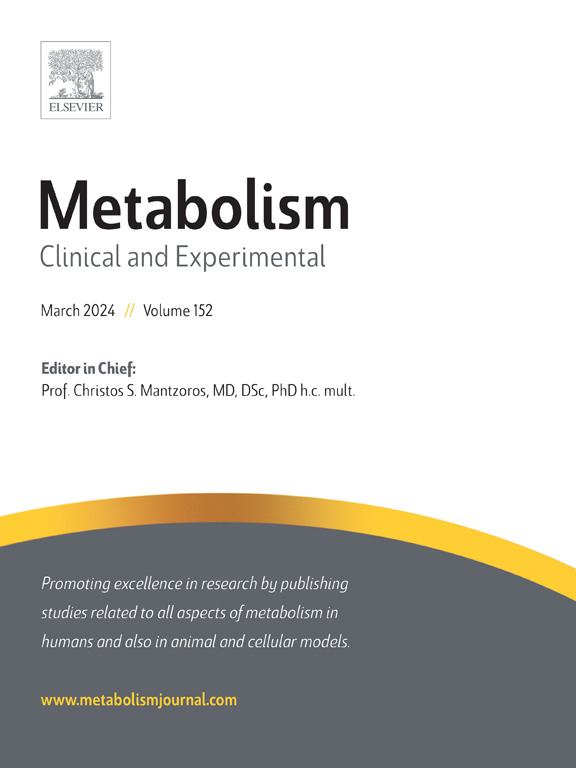ADH1C maintains the homeostasis of metabolic microenvironment to inhibit steatotic hepatocellular carcinoma
IF 10.8
1区 医学
Q1 ENDOCRINOLOGY & METABOLISM
引用次数: 0
Abstract
Steatotic hepatocellular carcinoma (HCC) has emerged as a significant subtype of HCC. Understanding the complex tumor microenvironment in HCC is particularly important for stratifying patients and improving treatment response. In this study, we performed proteomic analysis on clinical samples of steatotic HCC and identified human-specific gene alcohol dehydrogenase 1C (ADH1C) as a key factor. ADH1C is a favorable prognostic factor in both steatotic and non-steatotic HCC. ADH1C promotes fatty acid degradation through a novel non-enzymatic function, inhibiting the development of hepatocellular carcinoma. Specifically, in vitro experiments revealed that ADH1C interacts with splicing factor retinitis pigmentosa 9 (RP9) to enhance the splicing of key transcription factor peroxisome proliferator activated receptor alpha (PPARa) pre-mRNA, which is crucial for fatty acid degradation. The regulation of the ADH1C/RP9/PPARa axis was supported by in vivo experiments and clinical relevance. This leads to a reduction in the critical metabolite palmitic acid, subsequently decreasing the palmitoylation levels of oncogenic protein TEA domain transcription factor 1 (TEAD1), thereby regulating the hippo pathway and subsequent cell proliferation inhibition. Additionally, we found that ADH1C and PPARa can serve as combined biomarkers to distinguish between patients with steatotic and non-steatotic HCC. Combination therapy targeting ADH1C and anti-programmed cell death protein 1 (PD1) enhances the response of steatotic HCC to anti- PD1 immunotherapy. Our study revealed a central role of ADH1C/PPARa in lipid metabolism and HCC suppression. Targeting lipid metabolism via ADH1C/PPARa may provide new therapeutic strategies for the treatment of liver cancer.

ADH1C维持代谢微环境的稳态,抑制脂肪变性肝细胞癌
脂肪变性肝细胞癌(HCC)已成为HCC的一个重要亚型。了解HCC复杂的肿瘤微环境对于患者分层和改善治疗反应尤为重要。在这项研究中,我们对脂肪变性HCC的临床样本进行了蛋白质组学分析,发现人类特异性基因酒精脱氢酶1C (ADH1C)是一个关键因素。ADH1C在脂肪变性和非脂肪变性HCC中都是一个有利的预后因素。ADH1C通过一种新的非酶功能促进脂肪酸降解,抑制肝细胞癌的发展。具体而言,体外实验表明ADH1C与剪接因子视网膜色素变性9 (RP9)相互作用,增强关键转录因子过氧化物酶体增殖物激活受体α (PPARa)前mrna的剪接,这对脂肪酸降解至关重要。ADH1C/RP9/PPARa轴的调节得到了体内实验和临床相关性的支持。这导致关键代谢物棕榈酸的减少,随后降低致癌蛋白TEA结构域转录因子1 (TEAD1)的棕榈酰化水平,从而调节hippo通路和随后的细胞增殖抑制。此外,我们发现ADH1C和PPARa可以作为区分脂肪变性和非脂肪变性HCC患者的联合生物标志物。针对ADH1C和抗程序性细胞死亡蛋白1 (PD1)的联合治疗增强了脂肪变性HCC对抗PD1免疫治疗的反应。我们的研究揭示了ADH1C/PPARa在脂质代谢和HCC抑制中的核心作用。通过ADH1C/PPARa靶向脂质代谢可能为肝癌的治疗提供新的治疗策略。
本文章由计算机程序翻译,如有差异,请以英文原文为准。
求助全文
约1分钟内获得全文
求助全文
来源期刊

Metabolism: clinical and experimental
医学-内分泌学与代谢
CiteScore
18.90
自引率
3.10%
发文量
310
审稿时长
16 days
期刊介绍:
Metabolism upholds research excellence by disseminating high-quality original research, reviews, editorials, and commentaries covering all facets of human metabolism.
Consideration for publication in Metabolism extends to studies in humans, animal, and cellular models, with a particular emphasis on work demonstrating strong translational potential.
The journal addresses a range of topics, including:
- Energy Expenditure and Obesity
- Metabolic Syndrome, Prediabetes, and Diabetes
- Nutrition, Exercise, and the Environment
- Genetics and Genomics, Proteomics, and Metabolomics
- Carbohydrate, Lipid, and Protein Metabolism
- Endocrinology and Hypertension
- Mineral and Bone Metabolism
- Cardiovascular Diseases and Malignancies
- Inflammation in metabolism and immunometabolism
 求助内容:
求助内容: 应助结果提醒方式:
应助结果提醒方式:


